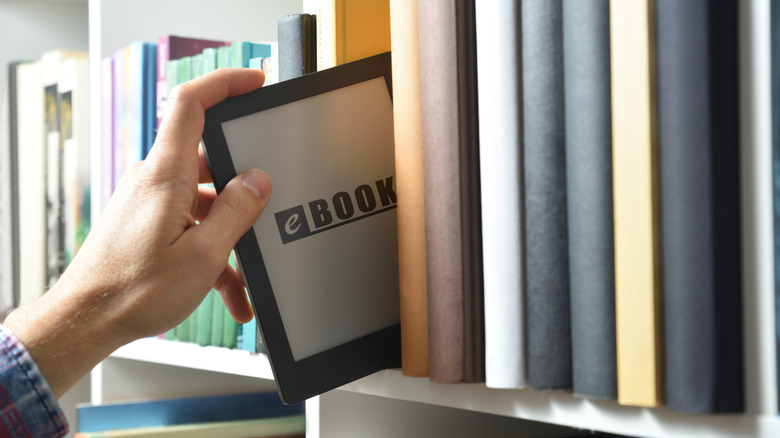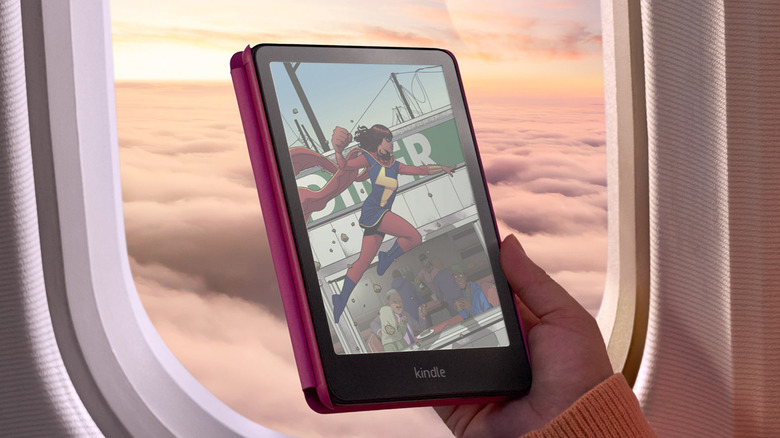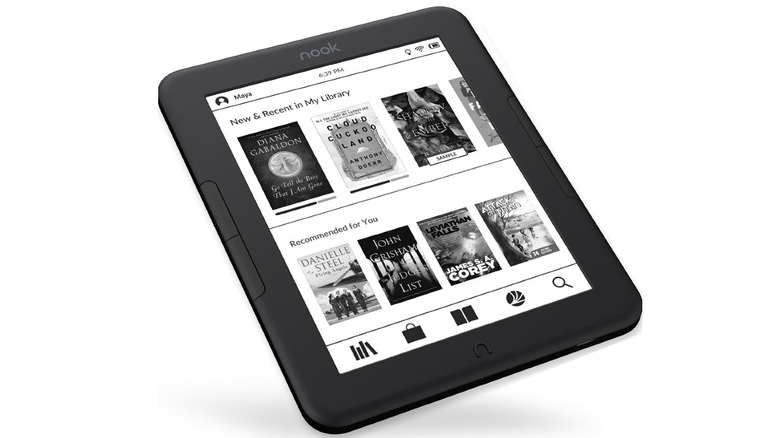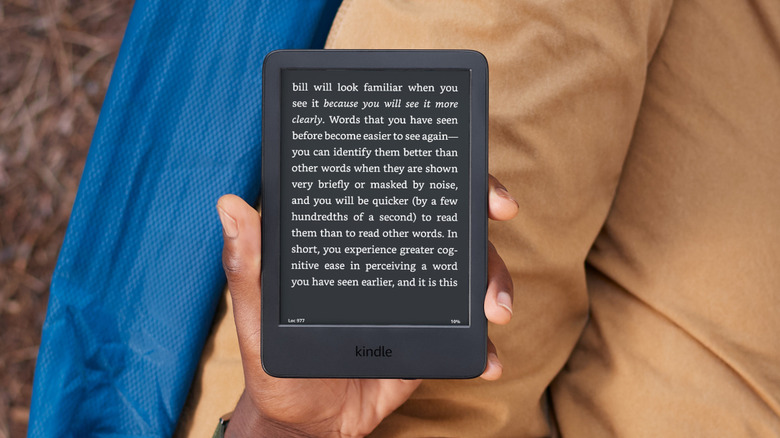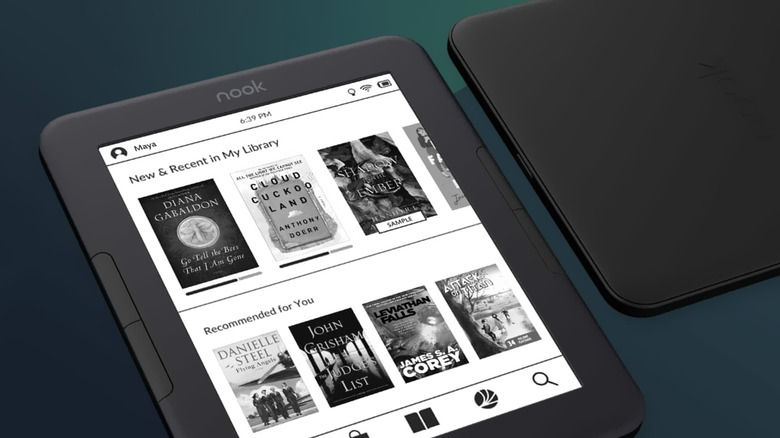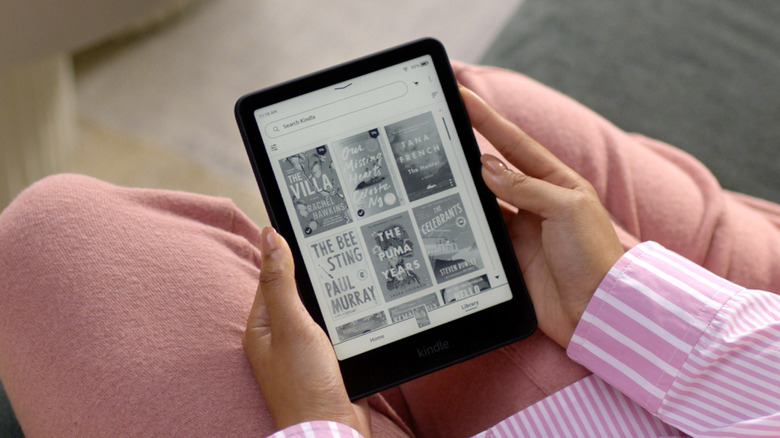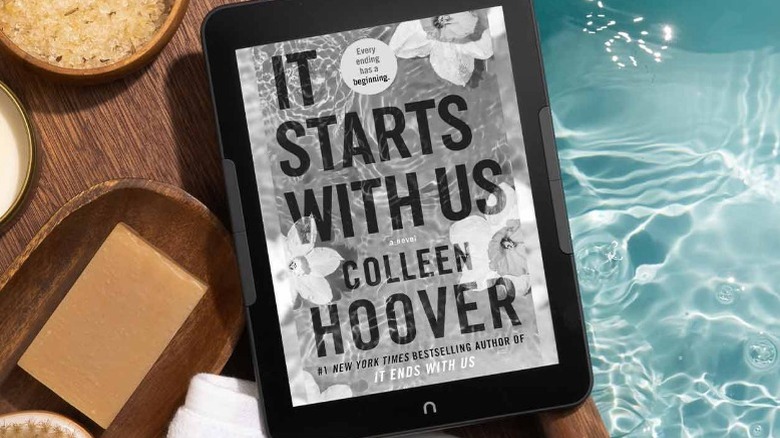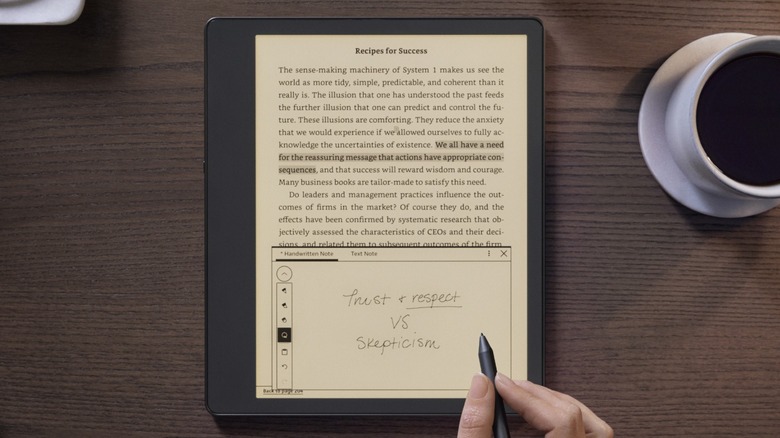Kindle Vs Nook: Which Is The Better E-Reader?
We may receive a commission on purchases made from links.
There are several different brands of e-readers on the market today, but Kindle and Nook have both been around since the technology first rose to popularity. Both of them are backed by major corporations, and both have managed to remain among the most prolific names in the industry in the years since their inception. Each of these companies offer several different models of e-readers — each equipped with its own unique set of specs and features that make them ideal for different kinds of readers. This can make the prospect of choosing one of the tablets offered by these brands somewhat challenging if you don't know much about the differences that set them apart.
Those who are looking to purchase a Kindle or Nook reading tablet might want to learn a bit more about what each of these companies and their respective products have to offer. You might want to know more about the brands themselves, the newest models that they have on the market, the pros and cons of each, and which of them has the edge in terms of price, library size, and quality. Arming yourself with these details will go a long way toward making an informed decision about which e-reader brand and model is right for you.
What is Kindle?
Kindle is one of the first names you'll see when you start looking at the different e-readers available on the market. This is because Kindle is owned by Amazon, which means that it's backed by the single largest online marketplace on the planet. This probably doesn't come as much of a surprise, though. Amazon started as an online book retailer, so it makes sense that the company would have a vested interest in technology related to reading. In fact, much of the current digital literary market was shaped by the corporation.
Amazon released the first Kindle back in November 2007, followed swiftly by the self-publishing service Kindle Direct Publishing. This meant that the company simultaneously established a method of publishing and selling e-books in an online marketplace without needing third parties. Just a few months later, Amazon acquired Audible, giving itself a foothold in selling audiobooks. The first Kindle was a boxy tablet by today's standards, but the design has continued to evolve over the years.
There have now been 12 generations of the standard Kindle, with the most recent coming out in 2024. The company offers an array of models with varying features and price points — all of which have access to every e-book and audiobook available through Amazon and Audible's respective digital libraries. Amazon also offers the Kindle Unlimited subscription service, which offers unlimited access to a curated library consisting of over four million books and thousands of audiobooks and magazines.
What is Nook?
Nook tablets are made by Barnes & Noble. While not quite as all-encompassing as Amazon, Barnes & Noble is easily the largest brick-and-mortar chain of book retailers in the U.S., making it an attractive option for consumers who prefer to buy tech in person. Like Amazon, Barnes & Noble also has its own publishing service and has access to a massive library of titles. The Nook has been around almost as long as Kindle, which is just part of the reason that many consider it to be one of the best non-Kindle e-readers on the market. That said, the technology has undergone quite a few changes over the years.
The first Nook was launched in 2009. It was unique when it first came out as it was the first tablet to combine e-ink technology with an LCD touchscreen at the bottom, allowing users to navigate menus and explore options in full color. Later iterations would add new features like free 3G connectivity and expand the range of size options and feature sets available. The company is now on its 4th generation of GlowLight tablets and has a couple of newer, higher-end product lines to fill out its catalog.
Nook readers can purchase and download any e-books available through Barnes & Noble's considerable digital library and audiobooks if they have a compatible device. Nook does not, however, offer any sort of subscription service.
What kind of e-readers does Amazon make?
There are five different Kindle models in the current lineup sold by Amazon. The standard Kindle has a 6-inch glare-free screen with an adjustable front light. It starts at $109.99, comes with 16 GB of storage, and promises up to six weeks of battery life.
The Kindle Paperwhite has a 7-inch glare-free display with a fully adjustable light that ranges from white to amber. The tablet promises up to 12 weeks of battery life and is waterproof. It has 16 GB of storage and starts at $159.99. Then there's the Paperwhite Kids edition, which has similar specs, but a few features that make it more tailored to younger readers. The model comes in three colorful cover designs: Cyber City, Starfish, and "Diary of a Wimpy Kid." The Kids version comes with a six-month subscription to Amazon Kids+ and has parental controls that can help you to add age filters, monitor reading habits, and set a device bedtime. This model costs $139.99.
Then there are the top-of-the-line models. The Kindle Scribe is a combination e-reader and digital notebook. It has a 10.2-inch screen and includes a stylus for annotating books or writing in the note-taking app. It comes in three storage sizes: 16 GB ($399.99), 32 GB (419.99), and 64 GB ($449.99). Meanwhile, the brand-new Kindle Colorsoft has a 7-inch glare-free e-ink screen, like the standard Kindle, but it's counted as one of the best e-readers with color displays out there. This is nice for book covers, but it also allows readers to highlight in yellow, orange, blue, and pink. It's waterproof, has 32 GB storage, and promises up to 8 weeks of battery life. This model costs $279.99.
What kind of e-readers does Barnes & Noble make?
There are currently three different Nook models on offer from Barnes & Noble. The Nook GlowLight 4 is the company's entry-level e-reader. The model has a 6-inch glare-free backlit touchscreen display that allows you to swipe to turn pages, but the tablet also has buttons on the side that offer a more tactile alternative. It has 32 GB of storage, promises up to a month of battery life, and is available starting at $149.99.
The Nook GlowLight 4 Plus is an upgraded version of this tablet. The model has many of the same features as its smaller sibling, but it's also waterproof, comes with a 7.8-inch screen, and offers audio support via both Bluetooth and a headphone jack, making it a better alternative for audiobook listeners. This model has 32 GB of storage and sells for $149.99. Nook doesn't specify its expected battery life, though it does claim that you can "read for weeks on a single charge."
The third model is the Nook 9-inch Lenovo Tablet. This isn't actually an e-ink tablet like the others featured thus far, but is rather a full HD 1340x800 LCD that is powered by a MediaTek Helio G80 processor running Android 13. This allows it to be used to read books, newspapers, and manga in full color. Nook also sells it in a Frost Blue Edition. This kind of tablet has less in common with the Kindle and Nook e-readers than it does with Amazon's line of Fire tablets, which were originally part of the Kindle line but dropped the name in 2014 when it wanted to separate the branding for the two types of devices.
The pros and cons of Kindle
Buyers will find many great reasons to go with a Kindle tablet: there are a wide range of models to choose from, with all of the newer editions having updated features like backlighting, Bluetooth connectivity for audio devices, as well as faster page turns, and higher contrast ratios when compared to previous models. All of these tablets have e-ink displays with clear lettering that mimic real paper and reduce eye strain when compared to other types of tablets. Likewise, the tablets offer long battery life, with even the smallest of them being able to last over a month on a single charge.
The standard Kindle and Paperwhite models are both on the more affordable side of the spectrum, while the more expensive Scribe and Colorsoft models offer unique functionalities that aren't available from e-readers sold by most other brands. As an Amazon brand, Kindle also has access to the biggest digital marketplace in the world, including titles that are exclusive to programs like Kindle Direct Publishing, as well as the Kindle Unlimited and Audible subscription services.
There are a few drawbacks to going with Kindle, though. To start, none of the Kindle tablets have a 3.5mm headphone jack, so users will need to rely on wireless audio devices to listen to audiobooks. There are some limitations on file support as well. While Kindles have now started supporting the popular PDF and EPUB formats, they still don't support FB2, CBZ, or a handful of other file types. Kindles are also famously locked into the Amazon ecosystem. Sideloading apps and internet browsing are difficult, so a Kindle might be less than ideal for someone who enjoys pulling content from multiple sources.
The pros and cons of Nook
There are several reasons to go the Nook route: they also have easy-to-read displays with 300-ppi resolution and built-in backlights, but the biggest reason you might choose Nook over Kindle is that you wouldn't be locked into the Amazon ecosystem. Nooks support a wider range of file types and are much more friendly to sideloaded apps. This makes it easy to integrate library apps, such as OverDrive (Libby), as well as other digital storefronts.
On top of that, the native Barnes & Noble marketplace is certainly no slouch. While not quite as big as Amazon, B&N still sells over 190 million books per year at its stores. On top of that, some Nooks do offer the 3.5 mm headphone jack, tend to offer more storage, and the physical buttons on the side of the Nook tablet allow readers a more tactile method of turning pages than swiping the screen. You can buy Nooks in Barnes & Noble retail stores in addition to online.
There are some downsides to going with Nook, though. There are only two e-ink tablets on offer, and neither of them has the sort of note-taking capabilities of the Kindle Scribe or the colored e-ink as seen with the Colorsoft. These models are more expensive than their Kindle counterparts as well. There's also the matter of software support. Nook is known to offer less frequent updates and has a tendency to only update the products that are a part of its current line.
Kindle vs. Nook – Kindle is the winner
The Kindle and the Nook are excellent devices with access to massive digital storefronts for readers. That said, the Kindle beats the Nook in almost every arena. It offers a wider range of products with comparable models at lower prices. Barnes & Noble simply doesn't have comparable alternatives to the Kindle e-readers with extra features like the Scribe and Colorsoft models.
Then there's the matter of digital content. E-book pricing between the two storefronts is nearly identical, with each occasionally undercutting the other by a matter of pennies, but it's hard to deny that Amazon offers a lot more options. It has more books thanks to the KDP exclusives that aren't sold anywhere else and the Kindle Unlimited and Audible subscription services offer unique ways for readers to get unfettered access to massive libraries of digital literature. This dramatically expands the utility of each of its tablets.
This doesn't mean that Kindle is the best choice for everyone. Some readers might prefer Nook for its third-party app support, physical buttons, and other distinctive features. Of course, there will also be those who might want to buy a Nook simply to avoid giving more money to Amazon. That said, it's hard to deny that the Kindle is the better value overall.
Kindle vs. other brands
Now that we've established that Kindle tablets have an edge over Nook, it might also be worth taking a look at how it compares to e-readers sold by other popular brands. It's worth noting that none of them will be able to compete with the size on Amazon's bookstore, but they do have several other features which readers may find attractive.
Kobo e-readers are owned by Rakuten. There are six models currently available: the Kobo Clara BW, Kobo Clara Colour, Kobo Elipsa, Kobo Elipsa 2E, Kobo Sage, and Kobo Libra Colour. These offer a wide range of specs and features including note-taking and color tablets, and are available at competitive price points. Like Nook, it has a more open ecosystem that allows for easy sideloading of third-party apps and connection to libraries.
Onyx Boox has what might be the biggest collection of e-ink tablets on the market. There are six models in its Tab Series, four (currently available) in the Note Series, four in the Go Series, two in the Palma Series, and a couple of other models that are currently out of stock. These represent a range of screen sizes, from 6.13 inches on the Palma 2 to 13.3 inches for the Tab X C. Boox tablets run Android and have full access to the Google Play Store. They're a bit more expensive and might not boast the same battery life, but they are among the most powerful and capable tablets on the market.
PocketBook also has a wide selection. The company offers six basic e-readers, three color e-readers, and three e-notebooks. Its products boast an open ecosystem, international support, and perhaps most notably, expandable storage via microSD card on many of its devices.
